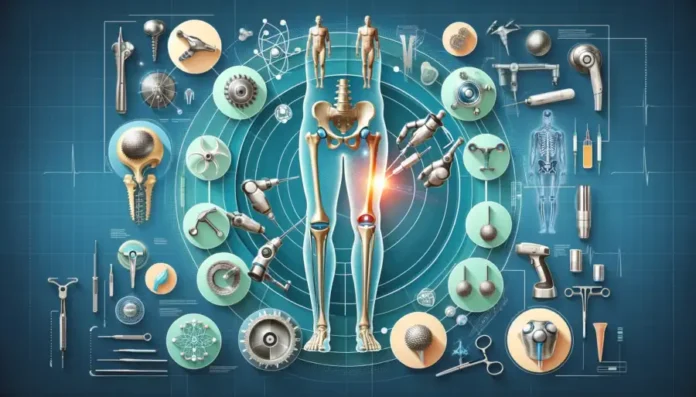Like many other Americans, you could be coping with a sore hip or a pair of creaky knees, particularly if the ageing process is beginning to take its toll. Going through a complete joint replacement procedure may seem intimidating despite your pain and agony; lengthy recuperation periods, hospital stays, swelling, and anguish are not anyone’s idea of fun. The good news is that if you’re on the fence regarding total knee replacement surgery, In recent years, total joint replacement has advanced significantly. Thanks to surgical advancements, you may return to your favourite activities with less discomfort, a quicker recovery, and fewer hospital stays. You might not be required to stay the night in many situations.
A surgeon may replace any joint in your body, but the two most common arthroplasty operations are hip and knee replacements, with significant advantages to knee replacement surgery. During this procedure, only the damaged joint component is replaced. In Dubai, there are famous orthopedic surgeons with years of expertise. Following an arthroplasty, recovery times might vary. Your age, conduct, kind of therapy, and the replacement joint influence this. There may be serious risks associated with postponing knee replacement surgery.
Advantages of Knee Replacement Surgery
The benefits of knee replacement surgery may be numerous.
Among them are:
- Not in pain
- Enhanced mobility
- increased life quality (since everyday duties and exercise are easier)
Research indicates that four out of five people who had a knee replacement done are happy with their new knees.
Modern Joint Replacement Surgery Techniques and Technological Developments
robotic surgery with assistance Robotic arms are used in both partial and whole knee replacements, as well as whole hip replacements to relieve joint discomfort. In Dubai, hip replacement surgery is available.
Replacement of a joint with robots
Surgeons may perform knee pain treatment more accurately and indindividualisationto robotic surgical arms. The robotic arm assists the surgeon in ensuring that every procedure is done exactly as planned.
Arrays, or tracking devices, are positioned around the patient’s knee or hip before surgery. These gadgets give the robotic arm information about the hip or knee’s location, orientation, and position. If the patient’s position changes, the machine’s arm can alter its alignment in real-time or stop the operation until the surgeon realigns the patient.
Navigating a computer
Before surgery, a patient’s knee or hip joint is modelled in three dimensions using computer navigation, which uses special specialised sensors. The surgeon can then use this model to help position the implant throughout the joint replacement process.
Specifically, computer software can assist the surgeon in lining up the new knee joint and the patient’s bones and ligaments during knee replacement surgery. Achieving alignment is crucial because it can lower the chance of destabilisation problems and increase the joint’s overall stability.
Cutting-edge imaging
Imaging methods like MRIs and X-rays have always been crucial before, during, and following hip and knee replacement surgery. A novel method now showing promise is a 3D recording of motion technology. With several cameras, this technology tracks a patient’s movements in actual time to offer better images of the joint before and after surgery. One type of imaging called fluoroscopy uses a continuous, high-resolution X-ray. It enables the physician to examine interior body pictures in real-time and evaluate joints and their movements from nearly any viewpoint.
Technology for augmented reality
HSS completed the nation’s first integrated reality-assisted knee replacement early in 2021. Using augmented reality (AR) “smart glasses,” doctors may see the patient’s knee structures and monitor surgical advancement in real time by overlaying the pictures over the surgical area. This is a variant of computer navigation. The surgeon may do this without turning upside down to look at a laptop screen. This technique might improve the placement of implants.
Technology for 3D printing
Creating an implant that will last a patient their entire life is the ultimate objective of any joint replacement. Joint implants with a customised patient’s unique anatomy can be created by HSS surgeons for some patients thanks to 3D printing technology. The need for fixing agents like bone cement may be lessened or eliminated with these personaliseds. The capacity of bone present to spread into the implant is also improved with customised. Patients with more complicated situations, such as those with past implant failures, should pay special attention to this.
Pain-relieving methods
At HSS, spinal anaesthesia, sometimes referred to as an epidural, is typically used during joint replacement surgery instead of general anaesthesia. This kind of anaesthesia helps manage pain right away following surgery since it wears off gradually. In addition, patients may be provided blocking of nerves in the vicinity of the joint replacement as the effects of the spinal anaesthesia wear off. Pain relief lasting up to thirty-six hours can be obtained by injecting medications into the spinal nerve above the knee. These medical treatments, together with drugs including antidepressants, anti-inflammatories, and pain relievers, assist to lessen the need for opioids and promote a quicker recovery.
For more information, visit ApzoMedia



































































